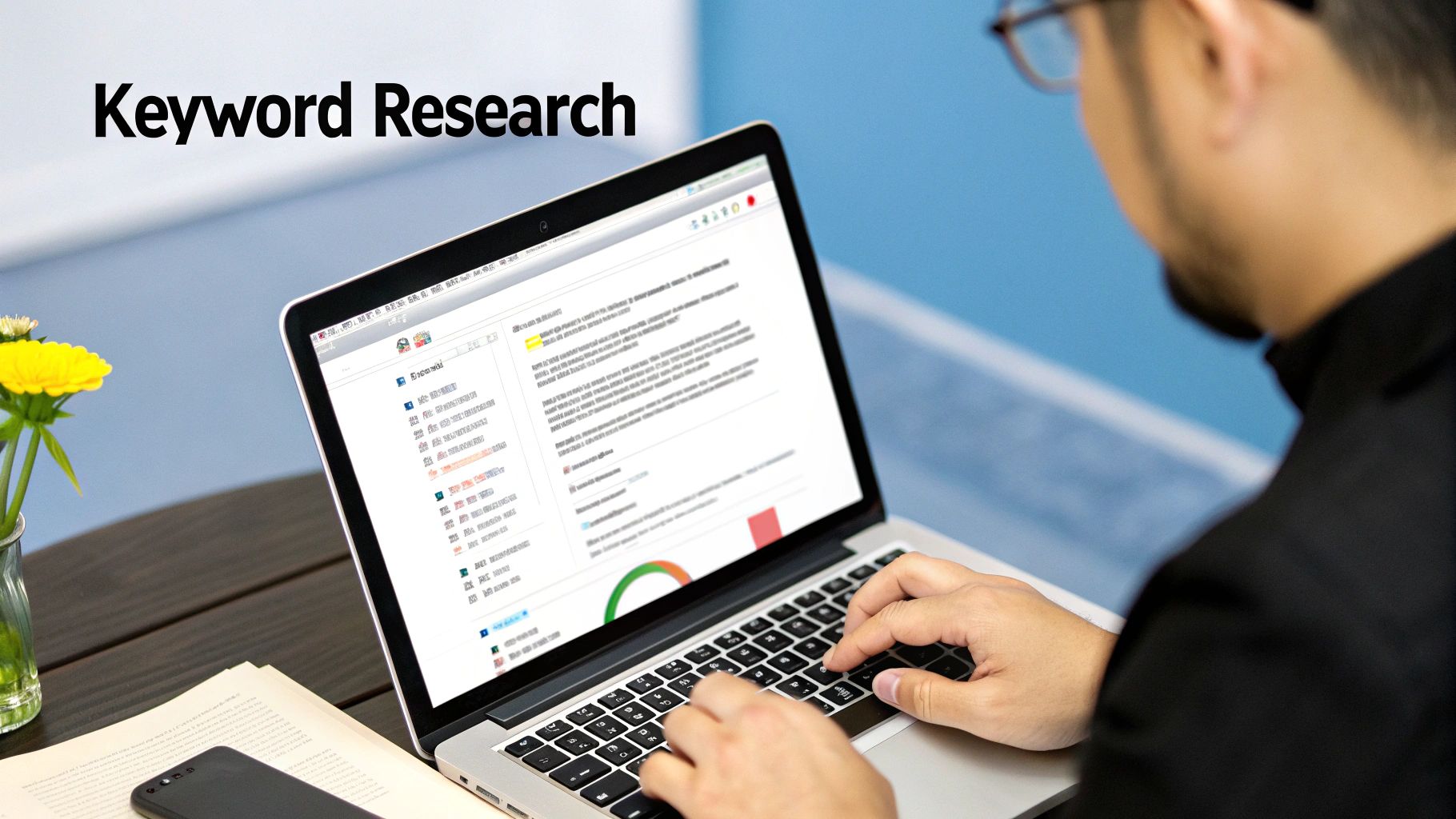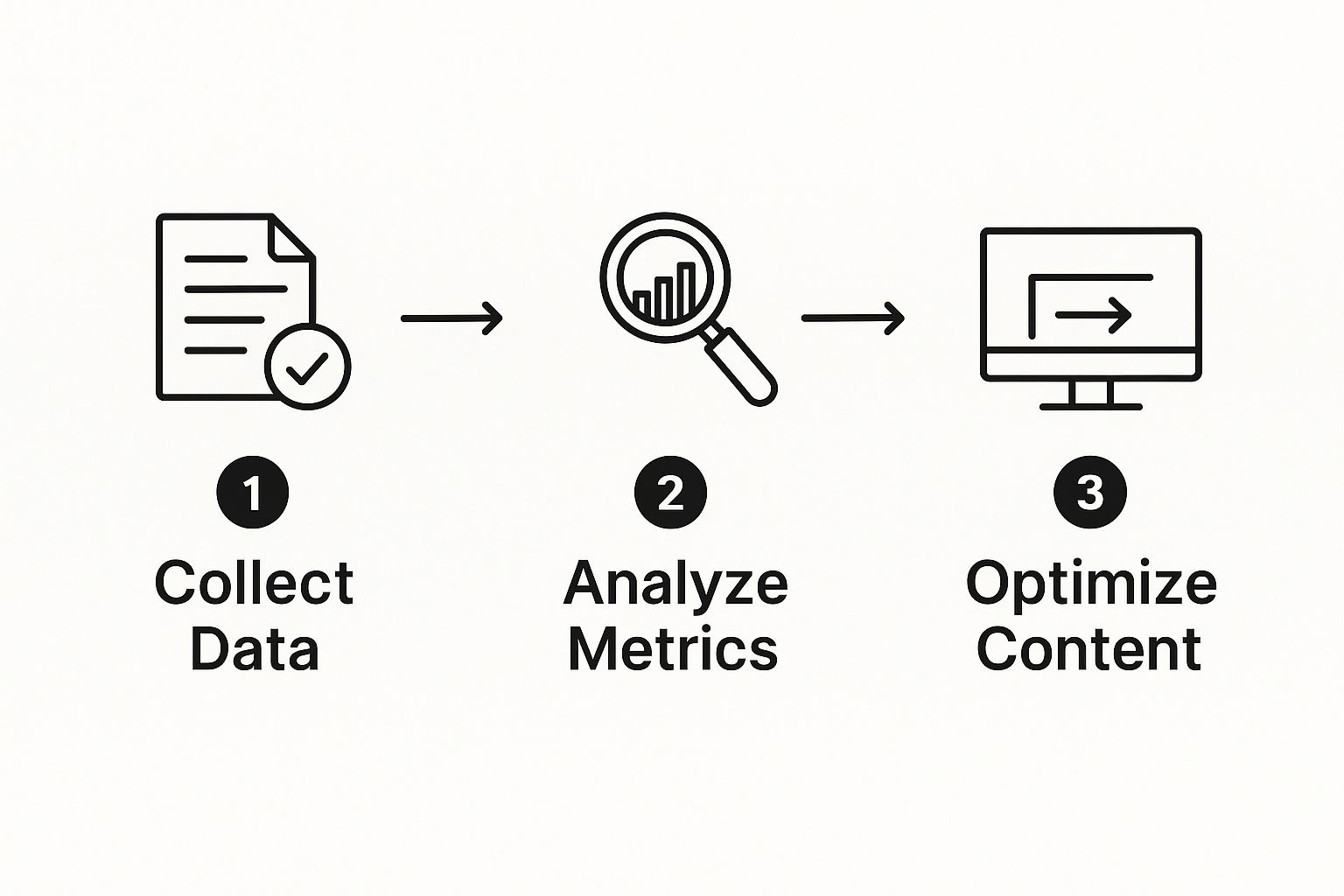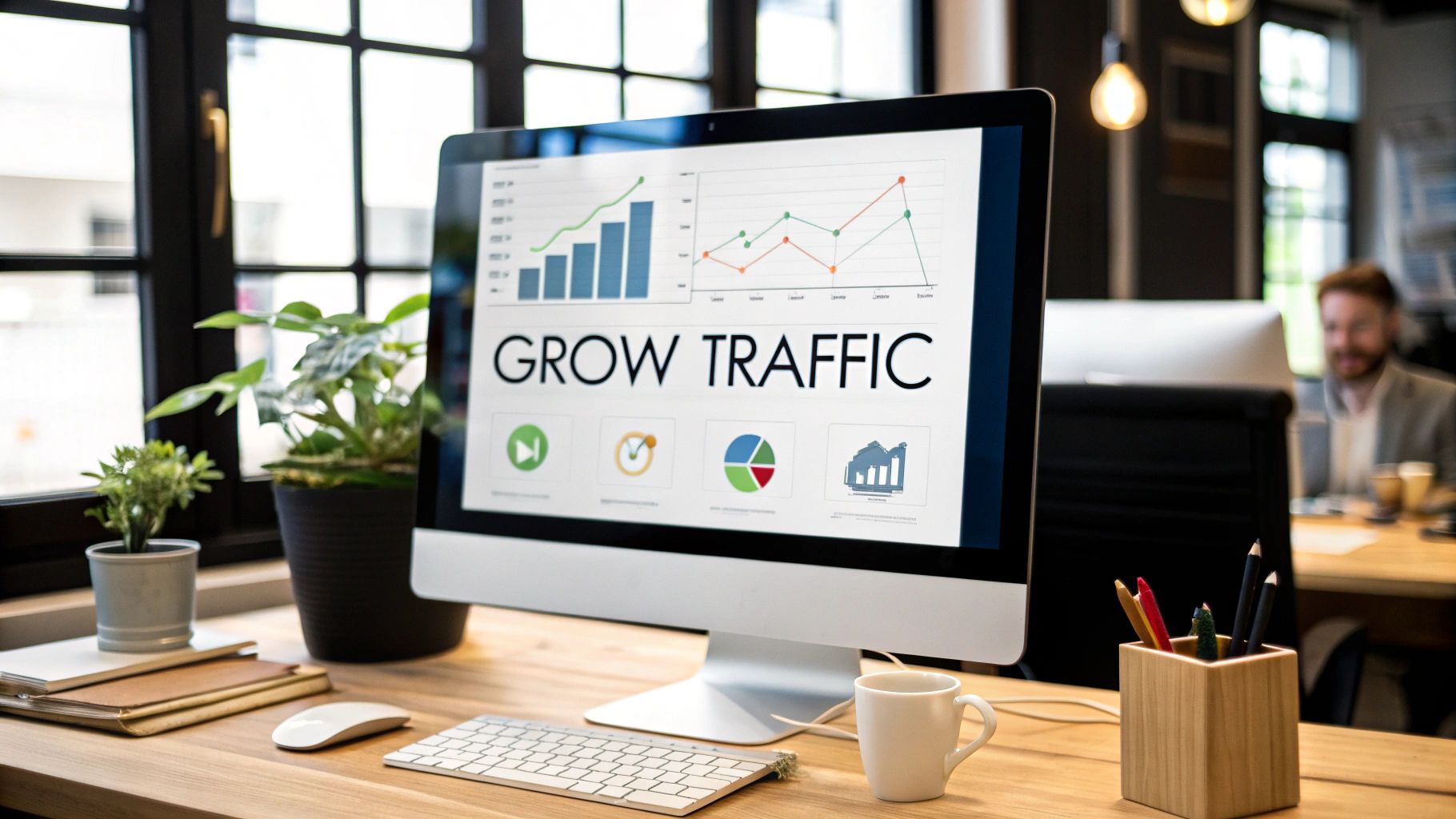Growing your e-commerce website traffic organically feels like an uphill battle, doesn't it? You're pouring money into ads, but the return on ad spend (ROAS) is shrinking, and you're struggling to attract high-intent customers. A common mistake we see is brands getting trapped in a cycle of expensive, low-margin traffic, ignoring the most profitable channel they have. The truth is that learning how to increase website traffic organically is your ticket to sustainable growth.
This isn't just about getting more clicks; it's about attracting qualified shoppers who are actively searching for what you sell. In this playbook, you'll learn exactly how to build a powerful organic traffic engine for your store. We'll walk you through the four essential pillars of SEO, from finding keywords that drive sales to creating content that Google and your customers will love.
Building Your Foundation for Organic Growth

Before diving into complex tactics, let's talk about the bedrock of it all. From our experience with over 500 Shopify stores, the most common pattern we see is brands skipping the fundamentals that create long-term growth. They chase quick wins with paid ads, only to see their customer acquisition costs spiral out of control.
The reality is that organic search remains the lifeblood of a profitable e-commerce business. Think about it. When someone types "best waterproof running shoes for trails" into Google, they're not just window shopping—they're on a mission. Getting your product in front of that person is infinitely more valuable than interrupting their social media scroll with an ad.
Let the numbers do the talking. Paid ads capture only a small fraction of user clicks. According to data from SparkToro, organic search results receive over 20 times more clicks than paid search ads. To get started, you first need a solid grasp of what search engine optimization (SEO) is for business. It’s not some mystical dark art; it's a repeatable, strategic process for attracting high-intent buyers.
Our Expert Takeaway: Stop treating SEO as a "nice to have." It should be your most important customer acquisition channel. Think of it as an engine that works for you 24/7, bringing in qualified buyers even while you sleep.
To really win at organic growth, you have to master a few core concepts. Here's a simple table that breaks down the essentials we walk our own clients through.
The Four Pillars of Organic Traffic Growth
Getting these pillars right is the first real step toward building a predictable and profitable stream of traffic. It's a long-term investment, but one that pays for itself many times over for years to come.
Find Shoppers Ready to Buy with Smart Keyword Research
So many Shopify brands fall into the same trap: they go after keywords that are way too broad or have zero commercial intent. You might pull in a ton of traffic from a term like "fashion trends," but that traffic almost never turns into sales.
If you want to attract actual customers—not just casual browsers—you have to get serious about keyword research. This isn't just about finding any keywords; it's about digging up the exact phrases people use when they're ready to pull out their credit cards.
Stop Chasing Vanity Metrics and Start Targeting Buyer Intent
From our experience with over 500 Shopify stores, the brands that absolutely crush it in organic search are obsessed with buyer intent. They know the difference between someone typing in "what is vegan leather" (informational intent) and someone searching for "best vegan leather crossbody bag under $100" (commercial intent).
Your entire goal is to show up for that second searcher. You must shift your mindset away from chasing massive search volumes and instead zone in on highly specific, purchase-focused phrases.
Our Expert Takeaway: High traffic numbers are pure vanity if they don't lead to sales. Focusing on keywords with clear commercial intent will bring you fewer visitors, but they'll be far more valuable. You'll get the right people on your site—the ones actively looking to buy what you sell.
Why Long-Tail Keywords Are Your Secret Weapon
This is where long-tail keywords come into play, and they are an absolute game-changer. These are longer, more detailed search queries, usually three or more words. Sure, they have lower search volume individually, but they are so much less competitive and their conversion rates are through the roof.
Put yourself in your customer's shoes for a second:
- Broad Keyword: "shoes" (Over a million searches, good luck ranking for that.)
- Better Keyword: "women's running shoes" (Still incredibly competitive.)
- Long-Tail Keyword: "lightweight waterproof running shoes for women" (Bingo. This searcher knows exactly what she wants.)
The person using that long-tail phrase is deep into their buying journey. It's no surprise that long-tail keywords now account for a huge portion of all searches. They work because they match user intent perfectly, driving targeted traffic that’s ready to convert. To get a better handle on where things are headed, it's worth understanding the future of organic search and how these trends impact your strategy.
Your Action Plan for Uncovering Keyword Gold
Alright, so how do you actually find these high-intent phrases? The strategy that consistently delivers the best results for our clients is always a mix of using the right tools and doing a little detective work on the competition.
- Start with Your Products as 'Seed' Keywords. Brainstorm the basic terms that describe what you sell. If you sell coffee, your starting point is "coffee beans," "espresso," and "cold brew."
- Plug Them into a Keyword Tool. Take those seed keywords and pop them into a tool like Ahrefs or SEMrush. Look for questions and phrases that include specific modifiers.
- Filter for Commercial Intent. This is the crucial step. Sift through your list and pull out keywords containing words like "buy," "best," "review," "sale," or specific product details (e.g., "organic cotton," "XL," "blue").
Here's a peek inside Ahrefs' Keywords Explorer, which is great for filtering keywords by volume, difficulty, and intent.
A view like this quickly tells you which keywords are worth your time and which are just too competitive for a growing brand to tackle right now. Here's a real-world example from a brand we work with: they were burning cash trying to rank for "women's dresses." We pivoted their strategy to focus on long-tail variations like "midi floral wrap dress for wedding guest." The result? In just six months, they tripled the organic traffic to their dress category, and the conversion rate from that traffic doubled.
How to Increase Website Traffic Organically by Creating Content Customers Love

Keyword research gives you the map—it tells you exactly what your customers are searching for. The next step is to give them the answer they're looking for. From our experience with over 500 Shopify stores, the single biggest thing that separates the brands that fizzle out from those that scale is the quality of their content.
Content is so much more than just blog posts. For an e-commerce store, it’s about creating genuinely valuable assets that solve problems at every stage of a customer's journey. This is how you build the trust and authority that fuels real, sustainable organic growth.
The Three Content Pillars Every Store Needs
A common mistake we see is brands putting all their eggs in one basket—usually just their product pages. To capture traffic from all angles and build a loyal following, you need a more balanced approach. The strategy that consistently delivers the best results for our clients is built on three core pillars.
Product-Led Content: This is your foundation. You must make your product and category pages the absolute best answer for someone with commercial intent. Go beyond basic specs. Use detailed descriptions, high-quality photos, customer reviews, and even short videos showing the product in action.
Problem-Solving Content: Think of this as your top-of-funnel magnet. This content answers the questions your customers are asking before they know they need your product. These are your "how-to" guides and buying guides. For example, a skincare brand might write, "How to Build a Simple Morning Skincare Routine," and naturally link to their products as the solution.
Brand-Building Content: This is where you tell your story. It’s the content that explains who you are, what you stand for, and why customers should choose you. This could be a compelling "About Us" page or a blog post about your sustainable sourcing practices.
This multi-pronged approach ensures you’re catching people's interest at every stage, building a relationship long before they add an item to their cart.
Your On-Page SEO Checklist
Creating amazing content is half the battle. You also have to structure it in a way that Google can easily understand and rank. When we onboard new clients, we run every key page through this simple on-page SEO checklist to ensure it is perfectly optimized.
Here’s the exact checklist you can use for your own pages:
- Compelling Title Tag: Is it under 60 characters? Does it include your main keyword and spark curiosity?
- Strategic H1 Heading: Does the page have one—and only one—H1 tag that clearly states the topic and uses the keyword?
- Engaging Meta Description: Is it around 155 characters? Does it summarize the page and include a clear call to action like "Shop Now"?
- Keyword in the First 100 Words: Did you naturally work your primary keyword into the first paragraph? This is a strong, immediate signal to Google.
- Smart Use of Subheadings (H2s, H3s): Have you broken up the text with descriptive subheadings to improve readability?
- Optimized Images: Are your image file names descriptive (e.g.,
blue-linen-shirt.jpg)? Have you added helpful alt text for every image?
A Note from the Trenches: Don't obsess over keyword density. Google got smart a long time ago. You should write for your customer first and focus on covering the topic thoroughly. When you do that, the right keywords will naturally find their way into your content.
Ultimately, great content does more than just drive traffic. It builds valuable assets that increase your brand's worth over time. By focusing on solving real customer problems, you'll not only attract more visitors but also see a direct impact on crucial metrics like customer lifetime value (LTV). You can use our free customer lifetime value calculator to see just how much small improvements in retention can boost your bottom line.
Fix the Technical SEO Issues Holding You Back
Think of technical SEO as the foundation of your house. You can have the most beautiful decor (your content), but if the foundation is cracked, the whole thing is unstable. This is what happens when you ignore the technical health of your website.
From our experience with hundreds of e-commerce stores, this is the most common reason a store's growth stalls. You don't need to be a coding genius to handle the essentials. You just need to make your site easy for Google to crawl, understand, and rank.
Your Site Speed is a Deal-Breaker
Let's cut to the chase: a slow website kills conversions and tanks your SEO. Google has been clear that site speed is a major ranking factor because users hate waiting, especially on mobile.
A slow site doesn't just annoy people; it tells Google that your user experience is poor, which directly hurts your ability to rank. One of the biggest culprits we see? Massive, uncompressed product images. It’s an easy fix with a huge return.
- Shrink your images. Before you upload a new photo, run it through a tool like TinyPNG. It's free and can slash file sizes by 50-70% without any noticeable drop in quality.
- Use the right format. Stick to JPEGs for photos and PNGs for graphics. Even better, look into modern formats like WebP, which offer superior compression.
- Turn on lazy loading. This feature only loads images as a visitor scrolls down the page, dramatically speeding up initial load time. Check your theme settings to ensure it's enabled.
Our Expert Takeaway: You should aim for a load time under three seconds. Every second you can shave off makes a real difference in how users—and Google—perceive your site.
Not sure where you stand? Pop your URL into Google's PageSpeed Insights tool. It's free, and it’ll give you a performance score along with a punch list of exactly what you need to fix.
Make Sure Search Engines Can Find Your Pages
Google can't rank what it can't find. The process of discovering your site's pages is called "crawling," and you can make this job incredibly easy for search engine bots.
- Submit Your Sitemap. A sitemap is a map of your website that lists all your important URLs. Shopify automatically creates one for you at
yourstore.com/sitemap.xml. You just have to copy that URL and submit it to Google Search Console. This is like handing Google the blueprints to your store. - Glance at Your
robots.txtFile. This is a simple text file that tells search engines which pages to ignore. Shopify handles this for you, but it’s worth a quick look to make sure you aren't accidentally blocking important collection pages.
Before you get bogged down in the details, a quick audit can tell you where to focus your energy. This checklist covers the basics that every e-commerce site owner should be on top of.
Technical SEO Health Checklist
Running through these checks quarterly is a great habit to get into. It helps you catch small problems before they become big ones.
Is Your Site Truly Mobile-Friendly?
This isn't a suggestion anymore—it's a hard requirement. Google now operates on a mobile-first indexing system, meaning it uses the mobile version of your website for ranking. If your site is a mess on a phone, your rankings will take a serious hit.
Yes, most modern Shopify themes are responsive, but you can't just assume it's perfect. The best test? Use your own phone. Navigate to your site. Is the text easy to read? Are the buttons large enough to tap? You can navigate the menu easily. This simple, hands-on test is often more revealing than any automated tool.
Building Authority with Backlinks and Digital PR

Think of your content and technical SEO as the engine of your store. What's the fuel? Backlinks. In Google's world, a backlink from a reputable website is like a powerful vote of confidence. It's one of the most effective ways to climb the organic rankings.
From our experience with over 500 Shopify stores, we've seen it time and time again: brands with a strong backlink profile consistently outrank their competition. It's a clear signal to Google that you're a credible, authoritative voice in your niche.
But let's be clear—this isn't about chasing spammy, low-quality links. That's a surefire way to get penalized. We’re talking about earning high-quality links from relevant sites that your actual customers read and trust. It's a long-term play that builds a defensible moat around your business.
Create Content That Begs to Be Linked
The strategy that delivers the best results is creating content so genuinely useful that other websites want to link to it. You can't just ask for links to your product pages and expect results; you need to create true assets for your industry.
Here are a few proven ideas that work:
- Original Research or Data: Survey your customers or dig into your own sales data to find a unique trend. A pet supply store could publish a report on the "Top 10 Most Popular Dog Breeds in Texas." This becomes a unique, citable asset that local news outlets and pet bloggers would share.
- The Ultimate "How-To" Guide: Aim to create the single best, most thorough guide on a topic related to your products. A brand selling coffee beans could create a definitive guide to "The 25 Different Ways to Brew Coffee at Home."
- Free Tools and Calculators: Develop a simple, genuinely helpful tool. A skincare brand might create a "Find Your Skin Type" quiz that offers tailored product recommendations. Interactive assets like this attract links like magnets.
Earning Your First High-Quality Links
Once you have something worth linking to, it's time to get it in front of the right people. This is where strategic outreach, or digital PR, comes into play. It’s all about building real relationships, not just blasting out mass emails.
A common mistake we see is brands aiming only for the biggest publications. Sure, a feature in a major magazine is fantastic, but links from well-respected, niche-specific blogs can be just as powerful and are often much easier to land.
Here's a real-world example: We worked with a client selling sustainable home goods. They created a beautifully designed infographic on "The Environmental Impact of Common Household Products." We then identified 50 mid-sized blogs focused on eco-friendly living and sent personalized emails offering the infographic to share with their readers. Over a dozen of them featured it, which drove thousands of referral visits and gave their domain authority a significant boost.
Your Action Plan for Link Building
Getting started can feel overwhelming, but you can break it down into a few manageable steps.
- Identify Your Linkable Assets: Look through your existing content. Do you have a blog post, guide, or tool that offers unique value? If not, make creating one a priority.
- Find Relevant Websites: Use simple Google searches like "best [your industry] blogs" or "[your topic] + guest post" to start building a list of potential partners.
- Get Featured in Product Roundups: Search for articles like "best [your product type] of 2024." Find the author and send a friendly email offering a sample for them to consider for a future update.
- Guest Post on Industry Blogs: Offer to write a high-value article for a relevant blog. Your author bio is the perfect place to include a link back to your store.
This process does more than just boost your SEO. It builds your brand's reputation, drives referral traffic, and gives you more opportunities for how to increase customer engagement by reaching new, relevant audiences.
Your 90-Day Organic Growth Action Plan
Alright, you've got the individual pieces of the puzzle. Now, the real magic happens when you put them all together into a system that builds momentum over time.
From our experience with over 500 Shopify stores, the brands who truly win at SEO don’t just throw tactics at the wall. They build a flywheel. Great content earns backlinks, those links boost site authority, and that authority makes it easier for all their other content to rank. The key isn't to do everything at once; it's about doing the right things in the right order.
Your First 90 Days
Let's be realistic. You can't fix everything overnight. The next three months are about focused, high-impact tasks. This is the exact approach that consistently delivers the best results for our clients.
Month 1: Lay the Foundation. Your first 30 days are for a deep keyword audit and squashing any critical technical SEO bugs. You must pay special attention to site speed and the mobile experience. Get them right, and everything else you do will work better.
Month 2: Create Your Pillars. This month is all about content. Your goal is to create five cornerstone pieces. Think comprehensive guides, not just short blog posts. You should target your most valuable long-tail keywords and create assets that will attract links and build your authority.
Month 3: Build Authority. With your cornerstone content live, it's time for outreach. Spend the final 30 days identifying 20 relevant blogs or publications in your niche. Your job is to start building genuine relationships that lead to your first high-quality backlinks.
To keep this all moving in the right direction, you need a simple way to measure, learn, and improve. It’s a continuous cycle. This flow chart breaks it down perfectly.

This simple loop—collect data, analyze what’s working, and optimize—is how you ensure your strategy is based on real performance, not just guesswork.
Once this flywheel starts spinning and you get that hard-earned traffic, the next challenge is turning visitors into customers. This is where you can use conversational marketing to not only close the sale but also find actionable ways to increase average order value from every new customer you acquire.
Got Questions About Organic Traffic? We've Got Answers.
We get these questions all the time from e-commerce brands trying to crack the code on organic growth. If you've been wondering about these things too, you're in the right place.
How Long Until I Actually See SEO Results?
This is always the first question, and for good reason. The honest answer? SEO is a marathon, not a sprint. It's an investment in your brand's future.
From our experience with hundreds of brands, you might notice some small movements in the first three months. Maybe you'll start ranking for a few long-tail keywords.
But for the kind of significant traffic that really moves the needle, you need to be patient. Realistically, it takes a solid 6 to 12 months of consistent work—publishing great content, earning links, and optimizing your site—to see sustainable results. Consistency is everything.
Should I Build Backlinks or Create Content First?
It's a classic chicken-or-the-egg scenario, but the answer is surprisingly clear. We see so many brands get this wrong by chasing backlinks before they even have a website worth linking to.
Your first move should always be building a strong foundation of high-quality, helpful content. Think about it from the other person's perspective: why would anyone link to a site that offers no real value?
Here's the approach that works time and time again:
- Start by creating a core group of 10-15 excellent, well-researched articles or guides.
- These become your "linkable assets."
- Then, you can shift some focus to strategic outreach to build links to those valuable pieces.
Does an E-commerce Store Really Need a Blog?
Yes. A thousand times, yes. A blog is one of the most powerful assets for an e-commerce business.
Your product pages are fantastic for targeting "buy now" keywords, but they have almost zero chance of ranking for the questions your customers ask before they're ready to buy. Think about queries like "how to choose the right running shoe" or "best gifts for coffee lovers."
That's where your blog comes in. It's your opportunity to answer those questions, build trust, and become a go-to resource. You get to introduce your brand to potential customers early in their journey, warming them up long before they even think about clicking "add to cart."
You now have a complete playbook for how to increase website traffic organically. Once you've done the hard work of building that traffic, the next challenge is turning those visitors into paying customers. That's where Kanal, as an official Meta Business Partner, comes in. We help you engage shoppers and bring back abandoned carts with automated WhatsApp flows that see a 98% open rate.
Ready to convert that traffic into revenue? Install Kanal on your Shopify store today or book a demo at getkanal.com/demo.



